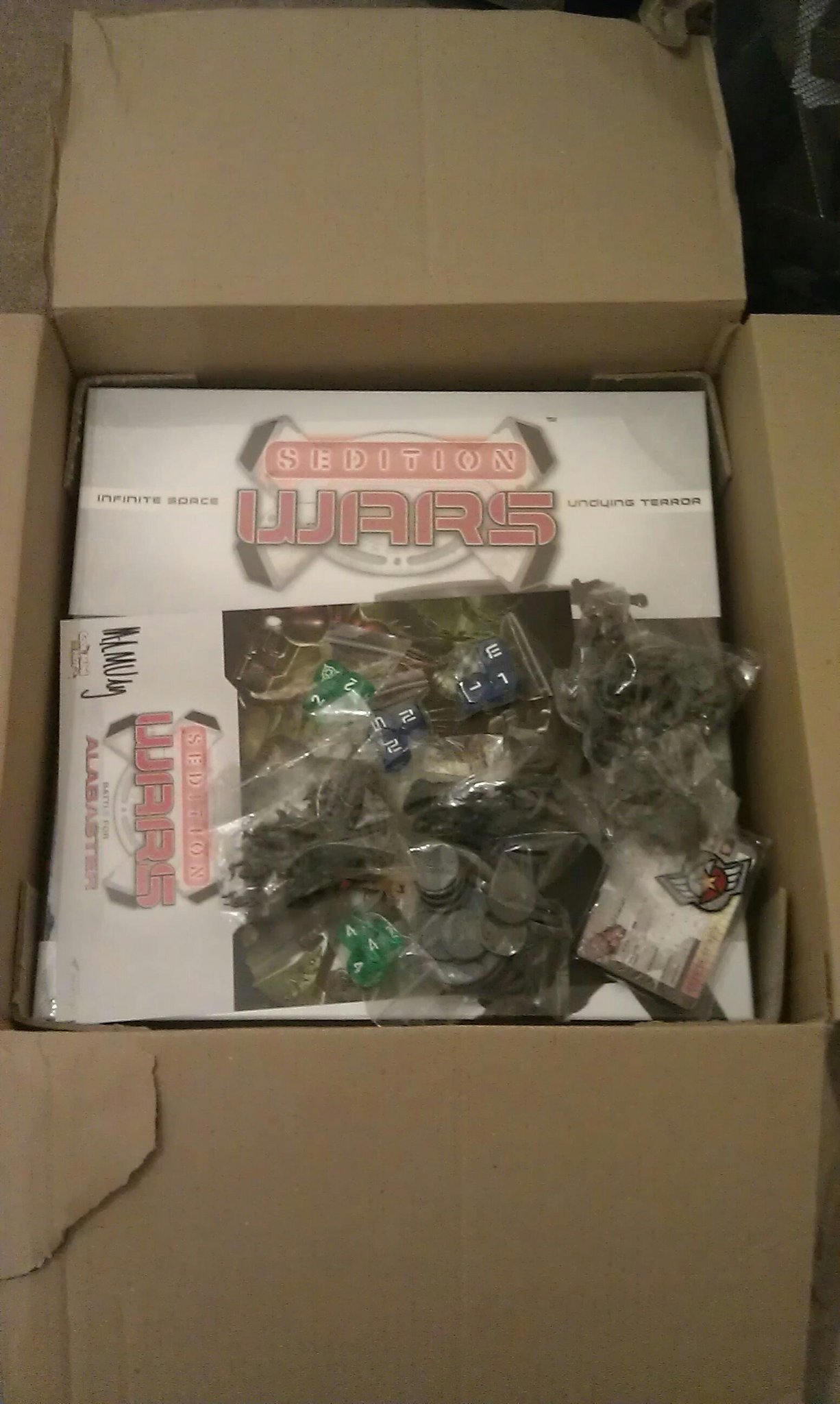Today was an exciting day. Late yesterday I had a confirmation from UPS that my long-awaited copy of Sedition Wars: Battle for Alabaster was finally starting its final journey from Essex to my front door. Given that I pledged toward to Kickstarter for it last June, I've spent quite a while looking forward to it!
Having tracked it onto a van at 7:30am, I spent most of the day with bated breath. Finally, at 4:30pm...
Let's take a look inside, shall we...?
First things first, I want to emphasise just how enormous the box is. Anyone who has played Super Dungeon Explore would be right to expect something about the same size. For those who haven't, here's a comparison to Warmachine: Prime (roughly US Letter size).
Actually, the Warmachine books are quite a good comparison. Both they and the Battle for Alabaster box have that nice part-glossy finish to them, and feel nice and touch. This box seems much less flimsy than my dim memories of the Super Dungeon Explore box, which can only be a good thing.
Pop open the box, and you're greeted with STUFF!
Where to start, where to start? Let's take a look at the map tiles. There are five of them, and they're double-sided. It seems like the prefabricated scenarios (of which more later) only use 3-4 of these, so there are quite a lot of possible combinations.
As you can see, they're as big as the box. In other words, they're BIG. The artwork is dark, but really nice, and packed with characterful details. The different tiles do a good job of retaining distinct characters, allowing them each to tell their own part of the story.
The other two big sheets of card in the box contain a multitude of tokens just waiting to be pushed out:
In the foreground, you can see the wealth of cards and plastic tokens that also form part of the extensive set of play aids. But you can't really see them from here, can you? Let's go in closer...
The cards, of which there are several (there's one for each model in the game, including the many duplicates), are all full-colour, and double-sided. They look to be quite easy to read, but I'll admit that the rules contained on them don't mean much to me at the moment.
You might be wondering about those green square tokens two pictures ago. Here's one, along with some dice. Everyone likes dice, right?
The standard game actually comes with some boring black D6s, but the Kickstarter campaign was offering these snazzy transluent dice marked with symbols for the Strain and Vanguard. You can't see it here, but the typeface differs between the two types of dice, which is a nice touch. You might recognise the symbol on the green token. In fact, it represents the strain's nanovirus, which floats around the stricken Alabaster Station causing all manner of unpleasantness of the beleaguered Vanguard.
The red and blue discs among the tokens are another nice little feature. They're actually designed to clip onto the bottom of models' bases to represent different in-game effects. I've not seen this done before, but it strikes me as being rather nifty. Take a look for yourself!
While we're looking at bases, it's worth pointing out that there are several different designs of base included with the figures. There's a single common design for the handful of big beasties, but no fewer than six variations on clean, sleek sci-fi basing for the small-based folk.
So, having got to the bases, I guess you're probably expecting to see some miniatures now, right? Wrong. They're so numerous, I want to take a more careful look at those before I report back, so you'll have to come back and read part II, which I'll probably write at the weekend.
What I can show you a little more of, however, is the rulebook. Weighing in a almost 60 pages of full-colour gloss, it certainly looks the part. It contains more-or-less what you'd expect: basic game rules, specific details on the forces of the heroic Vanguard and gribbly Strain, some nice bits of background text to help set the scene and a range of 9 exciting-sounding scenarios to guide players through the story of Alabaster Station. If that isn't enough, there are also rules for 'strategic' [read: generic] scenarios for those seeking a more 'pitched battle'-type affair. I'm planning to post more about the rules and scenarios themselves after I've had a chance to digest them, but for now feel free to cast your eyes over these few pages:
So, there we go for the first stage of the unboxing. So far, I feel quite impressed, and happy that I invested in a good product. Come back soon to see some pictures of the miniatures and, when I've read them through, my thoughts about the rules. After that, I guess I should find someone to play it with!














No comments:
Post a Comment